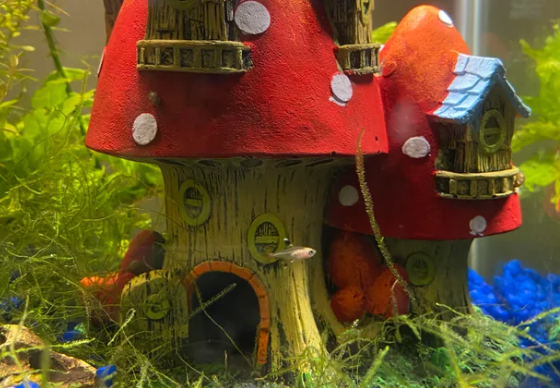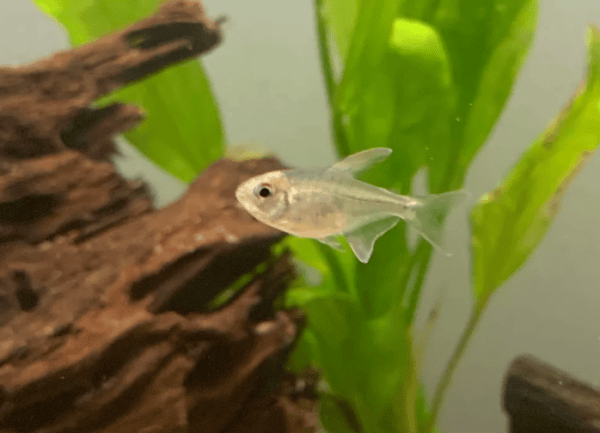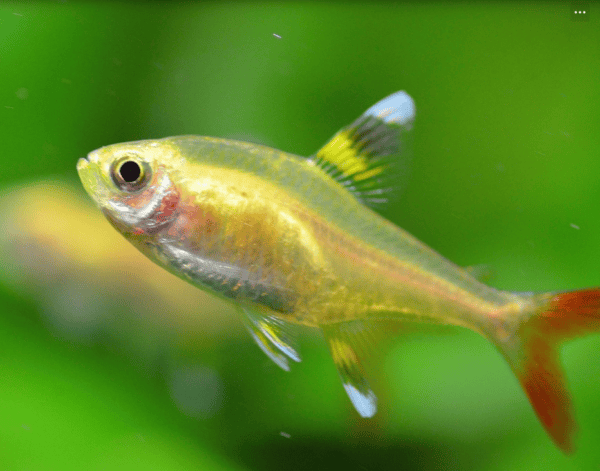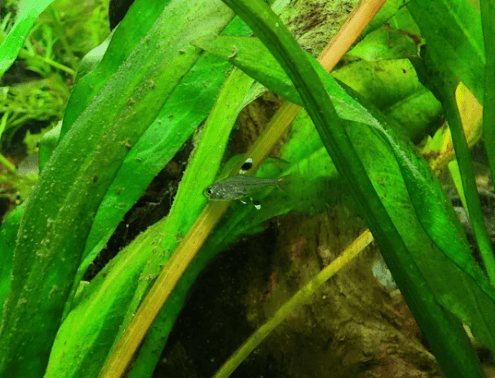Known as the Water Goldfinch, the Pristella Tetra (X-Ray Tetra), is a small freshwater fish that has an acute sense of hearing. Being omnivorous fish species, they predominantly help their ecosystem by controlling algae and larvae growth.
In addition to being extremely popular in the aquarium trade, they’re also used by researchers for their easy-to-study transparent bodies.
In this article, we’ll go through the key care details of Pristella Tetra and inform you about their requirements in depth.
Table of Contents
Pristella Tetra Overview

Native to Southeast American countries like Brazil, Guyana, and Venezuela, the Pristella Tetras inhabit the Amazon and Orinoco River basin and their contributory rivers. They’re identified by their translucent layer of skin and black-striped fins.
They typically are pretty peaceful fish, preferring to stay in a group of at least six. They also prefer to exhibit schooling behavior for safety and breeding.
| Information Chart | Pristella Tetra |
| Scientific Name: | Pristella maxillaris |
| Family: | Characidae |
| Care Level: | Easy |
| Temperament: | Peaceful and social. Schooling fish. |
| Color: | Silver body with black stripes. Translucent body. |
| Lifespan: | 3 to 5 years |
| Size: | 2 inches |
| Diet: | Omnivorous |
| Minimum Tank Size: | 20 gallons for a small group |
| Temperature: | 72 to 78 F |
| WaterConditions: | Slightly acidic water. pH 6.0 to 7.5. Water hardness of 5 to 15 dGH |
| Tank Mate Compatibility | Other peaceful fish species |
Pristella Tetra Appearance
The most unique external feature of Pristella Tetra fish is the translucent skin that allows the backbone to be visible from the outside. Owing to their Water Goldfinch name, the scales of X-Ray Tetra reflect golden and yellow shimmer.
Most individuals of this species have a red-tipped tail with vibrant dorsal and anal fins with yellow, white, and black stripes.
Internally, Pristella Tetra has a bony Weberian apparatus structure that helps it maximize sound waves and contribute to the acute sense of hearing—sensing both predators and food.
Demonstrating slight sexual dimorphism, female Pristella Tetras are fuller and larger. However, it’s almost impossible to identify them except during breeding seasons.
Types of Pristella Tetra
There aren’t any recognized types of Pristella Tetras in the wild, but color variations of the same species are present. Some of them are:
- Golden Pristella Tetra
The most common type of Pristella Tetra, with a golden body and black stripes.
- Albino Pristella Tetra
White or pink body, with red eyes. It also lacks the identifiable red hue in its tail.
- GloFish Pristella Tetra
Genetically modified to demonstrate bio-luminescence. Comes in a variety of three vibrant colors.
Lifespan of Pristella Tetra
On average, Pristella Tetra has a lifespan of 3 to 5 years in captivity with proper care and diet. However, as too many factors come into play, it’s hard to predict the accurate lifespan of each fish.
To ensure that your Pristella Tetra leads a healthy and fulfilling life:
- Provide them with proper water conditions and parameters.
- Keep them away from stress and injuries by avoiding predators.
- Give them enough hiding spots and enough space for schooling.
Pristella Tetra Size
Pristella Tetra is a relatively smaller fish species with a maximum length of 2 inches observed in captivity. Nutrition and proper care are also contributing factors to the size of Pristella Tetra. A few elements that may restrict their growth are:
- Genetics. Genetic makeup often determines how large or how fast your Pristella Tetra may grow.
- Too small of a tank size can restrict their growth.
- Not offering proper nutrition hinders their growth.
- Aggressive tank mates and increased stress can lead to reduced growth.
Natural Habitat
The X-Ray Tetras inhabit slow to moderately-moving rivers in their native Amazonian basin. Typically, sandy or muddy substrates are observed in these areas, with a few splatters of gravel and rocks.
In terms of vegetation, Pristella Tetra prefers areas with dense vegetation with lots of aquatic plants and submerged roots. These plants offer shelter, protection, and foraging opportunities to the small fish species.
Despite their heightened sense of hearing and agility, natural predators, such as birds, bigger fish, and reptiles are often observed in the wild.
However, their numbers are abundant in nature, and aren’t considered a vulnerable species.
Pristella Tetra Care & Tank Set-Up

In this section, we’ll shed light on the tank specifications, water parameters, and tank landscape suitable for your group of Pristella Tetra.
1. Pristella Tetra Tank Size and Specifications
The Pristella Tetra tank size and shape depend on the number of individuals you intend to keep. Here is an in-depth guideline for the same.
Optimum Tank Size
The minimum required tank size is 20 gallons for keeping a school of six Pristella Tetra. With every additional inclusion, you need to increase it.
Although they’re smaller fish species, they require adequate space to actively swim and demonstrate shoaling behavior. A confined space may hinder their natural growth and cause physiological issues.
Filter Type
Unless your tank is heavily stocked or is relatively large, a canister filter might be overkill. Hang-on-back (HOB) or sponge filters are quite well-suited for species like Pristella Tetra with a low bioload.
We recommend HOB filters for their ability to deliver mechanical, biological, and chemical filtration to the tank.
Substrate
Mimicking their natural habitat. A sandy substrate with the occasional introduction of gravel and rocks is arguably the best setup for Pistella tanks.
You may also cover the bottom with planted substrates to grow vegetation and blanket them with sandy substrates to provide a more natural environment to your Pristella community.
Small gravels and pebbles may also be used, but they don’t necessarily make the best habitat for this species.
How many Pristella Tetras are in a 20-gallon tank?
You can keep 6 Pristella Tetras in a 20-gallon tank.
2. Water Parameters for Pristella Tetra
As for water parameters, Pristella Tetra prefers slightly acidic water. In addition, they also can tolerate mildly brackish water.
Water Temperature
The appropriate water temperature to keep Pristella Tetra is around 72 to 78 F or 22 to 26 C, which is similar to the temperature in the Amazon River basin.
For starters, here are a few tips to help you maintain the water temperature in your aquarium:
- Use an adjustable heater if the atmospheric temperature is too cold. Keep the tank indoors to avoid condensation.
- Use a flow generator to increase water flow and reduce temperature.
- Facilitate water change with cool water if the temperature is too high for Pristellas.
Water Flow Rate
Pristella Tetra doesn’t prefer or require a strong water current. Mild to moderate water flow or 10-20 GPH is enough for them to thrive. They shouldn’t be subjected to a current that may prevent their agility and maneuverability.
This is also the reason why a canister filter isn’t recommended for small Tetra tanks. Keep the flow rate maintained and make sure that they aren’t pulled towards the filter or pushed away dangerously from it.
pH Level
As discussed, a mildly acidic pH of 6.0 to 7.5 is optimum for Pristella Tetra. You may:
- Neutralize high or low pH with RO/DI water through water changes.
- Use commercial pH buffers.
- Decorate the aquarium with driftwood and Indian Almonds to reduce pH.
- Introduce crushed coral as a substrate or filter media to raise the pH.
The use of water test kits is recommended to know the pH levels, but behavioral changes, rapid breathing, gasping, pale coloration, and aggression may also indicate tank pH issues.
Water Hardness
A moderate 5 to 15 dGH water hardness is adequate for Pristella Tetra. Consider:
- Using RO/DI water to regulate water hardness.
- Testing tap water before committing to use it.
- Using driftwood and other tannin-releasing plants.
3. Pristella Tetra Tank Landscape
Except for a few, most aquarists prefer having some kind of tank decorations and plants in their aquariums. Others are more lenient towards having bare bottoms. In this section, we’ll hint at the best and worst plants for your Pristella tank with decorations and lighting.
Best Plants for Pristella Tetra Tanks
Plants are almost indispensable in Pristella Tetra aquariums. The best plants for these tanks include
- Java Fern. Durable plants with large leaves. Can be anchored to driftwood and rocks.
- Anubias. Similar in characteristics to Java Fern. Also can be attached to driftwood and rocks.
- Amazon Sword. Large plants with broad leaves. Suitable to create lush backgrounds.
- Water Wisteria. Plants with soft split leaves with lots of hiding space.
- Cryptocoryne. Hardy plants with long leaves. provides cover to Pristella Tetras.
- Brazilian Pennywort. Plants with small round leaves.
Worst Plants for Pristella Tetra Tanks
Any plant that can’t withstand acidic environments isn’t suitable for Pristella Tetra tanks. In addition, densely bushy plants may restrict the swimming space for the tetras in their relatively small tanks. Plants with sharp leaves should also be avoided as they may damage their fins.
Decorations for Pristella Tetra Tanks
Generic aquarium decorations are a great starting point for setting up Pristella Tetra tanks. These may include:
- Driftwood
- Rocks
- Caves and hideouts
- Live plants
- Floating plants, such as Water Lettuce or Amazon Frogbit
- Aquarium-safe ornaments where the Tetras can play and hide
Lighting for Pristella Tetra
Pristella tetras don’t have any specific lighting requirement. But, you should try to simulate natural lighting conditions for the sake of your plants and other aquarium members. Generally, a moderate to low light should be sufficient for Pristella Tetra.
Feeding Pristella Tetra

Proper nutrition is critical for sustaining a healthy fish tank. Pristella Tetra is an omnivorous fish species that can be kept healthy and growing through most kinds of pellets and live food.
Best Diet for Pristella Tetra
Here are a few balanced diet options that you can offer to your Pristella Tetras:
- Flakes
Commercially available flakes made exclusively for omnivorous fish are well-suited for the nutritional requirements of this species.
- Pellets
Micro pellets specially made for Small fish species are great for Pristella Tetras.
- Live Food
To add a bit of variety to the diet, introduce live mosquito larvae, bloodworms, and artemia as food for Pristella Tetra.
- Frozen Food
Frozen brine shrimp, bloodworm, and mysis shrimp are well-suited for Pristella Tetra.
How often should you feed Pristella Tetra?
You should feed your Pristella Tetra 2-3 times a day in proper portions. I give them as much food as they can in around 3 minutes.
Pristella Tetra Behavior and Temperament
Generally, Pristella Tetra is a pretty peaceful and social fish species. Being smaller and having a wide range of natural predators, they’ve developed shoaling and schooling behavior, where they form a large group and stay in proximity to each other for food and safety.
They also exhibit a unique frightened behavior, where, when startled, they tend to dart away from the threat and hide behind plants and other places. You may observe this behavior more when they’re yet to acclimate to the environment.
Pristella Tetra Tank Mates
Despite being pretty small and timid, this species of freshwater fish prefers other peaceful companions in their tank. While they hold an exclusive preference towards their own, they don’t mind others.
Ideal Pristella Tetra Tank Mates
The ideal X-Ray Tetra Tank Mates may include,
- Other tetra species, such as Neon Tetra, Cardinal Tetra, Ember Tetras, etc.
- Rasboras, such as Harlequin Rasbora and Chili Rasbora.
- Corydoras Catfish and other peaceful bottom-dwellers.
- Peaceful livebearers like Guppies and Platies.
- Dwarf Gouramis can do pretty well with Pristella Tetras.
Bad Tank Mates for Pristella Tetra
In addition to any fish being incompatible with the water parameters, overtly aggressive fish and predatory fish are ill-suited in Pristella tanks. A few examples of such are:
- Larger Cichlids and Aggressive Barbs.
- Larger predatory catfish or pufferfish.
- Fish with long flowing fins may also allure Pristella Tetras to nip on them.
Breeding Pristella Tetra

Baby Pristella Tetras hatch in about 24 to 48 hours after their mother has scattered the eggs. While the whole breeding process is both easy and quite rewarding, it requires a few considerations.
- Tank Setup
Prepare a separate breeding tank with similar conditions as the main tank. Include soft trees and spawning mops where the eggs can be laid.
- Pairing
Provide ample hiding spots and introduce enough females and a limited number of males to avoid aggression. Observe the signs of courtship.
- Fertilization
Once the female is ready, it scatters the eggs throughout the plants and the spawning mops. The male follows the female and fertilizes the eggs.
Separate the eggs from adult Tetras. Eggs usually hatch after a day or two.
- Raising Fry
The fry absorb their yolk sacks before starting to swim freely. Feed them infusoria, liquid fish food, and crushed flakes in the initial stages.
Common Pristella Tetra Diseases and Their Treatment
These Tetras are very resilient. They don’t usually develop diseases in well-maintained aquariums despite community outbreaks. Regardless, a few common Pristella Tetra diseases can be noticed.
Dropsy
Is Identified by fluid accumulation inside the body cavity and tissues. Huge swollen belly and ulcers are common symptoms. Dropsy usually is a symptom of a more fatal underlying issue. Usual treatment includes addressing the issue and treating it.
Hole-in-the-head Disease
Small holes appear on the Tetra’s body and near its head. It often looks like a worm infestation and can’t be cured without Direct application. Metronidazole is a particularly effective medication.
Ich
Small white spots appear on the body and fins of the fish. In advanced stages, the spots often combine to create white patches. Common symptoms include scratching against rocks and increased gill movement.
Fin Rot
Split fins, rotten white edges, and ragged bodies are clear indications of fin rot disease in Pristella Tetra. Usual treatment involves isolation, antifungal medication, and increasing aquarium salt.
Are Pristella Tetra Right For You?
Pristella Tetra is right for beginner aquarium enthusiasts with minimal to zero fishkeeping experience. They also can withstand broad water parameters and often are hardy enough to prevent diseases on their own.
FAQ
No, Pristella Tetra is a quiet, peaceful, and social species. They aren’t recommended to be kept with other aggressive species or even larger peaceful species.
Most pristella Tetras grow around 1.5 to 2 inches. A few of them may get a bit larger, depending on genetics and nutrition.
Yes, your Pristella Tetra may eat smaller shrimp species like Dwarf shrimp and their fry.
The Bottom Line
This article intends to inform you about the care requirements of Pristella Tetra or the X-Ray Tetra. Hopefully, as a beginner, you’ll now be able to offer your colony of Pristella Tetra a healthy and safe home in the form of your freshwater aquarium.
No related posts.
